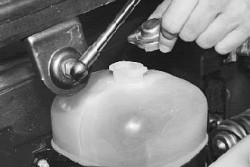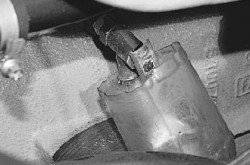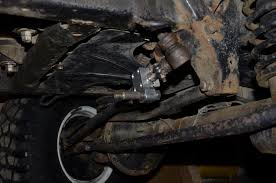The coolant in the UAZ Patriot, as in all cars with internal combustion engines, is used to maintain the operating temperature of the engine during its prolonged operation, that is, for intensive cooling. The UAZ Patriot engine cooling system contains about 9 liters of coolant; this must be taken into account when draining it, to select a container for collection. Also, the volume of coolant must be known in case of purchasing a new coolant, for replacing the old one.
So, after buying the coolant, whether it's antifreeze or antifreeze, it's up to you, we begin to replace it. By the way, when choosing a coolant, it will be useful to know information about what to take after all. Such information is given in the article “Which is better antifreeze or antifreeze”. It is also worth mentioning the frequency of replacing the coolant on the UAZ Patriot. The manufacturer recommends changing the coolant every 60,000 km or every 2 years. However, many UAZ Patriot car owners are forced to change the coolant already at TO1 (10,000 km), since the quality of the filled coolant leaves much to be desired.
The process of replacing coolant UAZ Patriot
To replace the coolant on a UAZ Patriot car, you will need a key for 14.
Initially, use the regulator in the cabin to open the heater (stove) valve of the cooling system, turning it all the way clockwise.

Unscrew the plug on the expansion tank

Next, remove the engine protection, since it will be impossible to drain the coolant and get to the valve on the engine block and the plug on the radiator without removing the protection.
Unscrew the cap on the radiator and drain the coolant from the radiator into a prepared container.

Then open the valve on the engine block and drain the coolant from the engine block. Also use a container to remove coolant.


Run the engine for a few minutes. Part of the coolant will go into the cooling system, displacing air pockets. Fill the expansion tank with coolant again to the required level.
Note: Change the coolant when the engine is cold, as there is a risk of burns. In addition, the coolant contains toxic substances that evaporate more actively and act on the human respiratory system if they are heated.
Of course, many car owners have repeatedly been faced with the question of how to properly drain (replace) antifreeze (antifreeze) in a UAZ car (UAZ)And UAZ Patriot (UAZ Patriot)! In this short article, many car enthusiasts will be able to find practical tips to solve this problem in the future.
How often to drain antifreeze from the UAZ Patriot engine
The answer to this question can be found in the manufacturer's recommendations. In this case, it is necessary to completely drain the antifreeze (antifreeze) from the engine block and radiator after 60 thousand kilometers or 2 years of operation. The fluid is replaced unscheduled if its color turns red. Such a change indicates that the inhibitory additives have lost their properties. As a result, the liquid becomes aggressive to the cooling system.
Note. Work on draining (replacing) the coolant is carried out on a cold engine. It is recommended to use fluids specified by the manufacturer.
How does it work car without replacing antifreeze
You shouldn't expect anything good from running an engine on a fluid that has exhausted its service life. An ineffective cooling system will lead to system overheating of the engine and, as a result, deformation of the cylinder head. A faulty cooling system is the number one mechanical failure on the road. Progressive corrosion can damage the engine over time. And this does not take into account the loss of engine power and increased fuel consumption.

Replacement procedure
Performance independent work draining (replacing) antifreeze will require a key, a 10-liter container, and a rag. The procedure for draining the coolant is as follows:
- The vehicle is installed on a level surface;
- The oil sump protection is removed;
- The heater valve opens by moving the lever all the way to the right;
- A tray for used antifreeze (antifreeze) is installed under the radiator;
- The plug is removed expansion tank;
- The radiator drain plug is unscrewed;
- The produced liquid is drained;

To drain the remaining antifreeze (antifreeze), you need to move the waste liquid tray under the cylinder block, unscrew the drain plug, and drain the remaining liquid. Then the drain plugs are screwed into place.
Note. If desired, you can flush the cooling system with running water. To do this, you need to pour water into the expansion tank, close the lid and start the engine for a few minutes. After this, drain the water according to the same procedure that was applied to the waste liquid.
While operating the vehicle, you need to check the level and monitor the condition of the coolant. Even without opening the expansion tank, you can tell by the color what the condition of the coolant is. In general, the expansion tank is not very expensive in the spare parts store, and if it is very dirty, it is better to change it at the next coolant change.
When adding coolant, you need to add only the liquid that was filled in; you cannot mix fluids from different manufacturers. A sharp increase or decrease in the fluid level while the engine is running is a signal of some kind of malfunction.
The liquid level in the expansion tank must be 3÷4 cm above the MIN mark. When starting the engine, the expansion tank plug must be closed. Do not pour liquid to the edge of the neck; as the temperature increases, the volume of liquid will increase, this can lead to swelling of the expansion tank and leakage of liquid.
In the version with the ZMZ-40904.10 engine, the expansion tank is installed under the hood on the front panel bracket on the left (Fig. 2) and there is no filler plug on the radiator.
To add fluid to a car with a ZMZ-409.10 engine:
We unscrew the cap of the expansion tank (Fig. 3) and add liquid through the funnel to the required level;
The coolant level in the radiator must not be lower than the edge of the filler neck (Fig. 4).
To delete air lock When adding liquid, you need to open the radiator filler cap.
On ZMZ-40904.10 vehicles, to fill the liquid, open the expansion tank cap, Figure 5, and fill in the coolant.
Coolant replacement
The coolant must be replaced after a mileage of 60,000 km or 2 years of operation. Of course, this period can also be reduced depending on the condition of the cooling system and the quality of the coolant.
The capacity of the cooling system of a UAZ Patriot with engines ZMZ-409.10 and ZMZ-40904.10 is twelve liters.
Coolant used: Coolant-40 “Lena”, Coolant-65 “Lena”, Tosol-A40M, Tosol-A65M, Shell safe
To change the coolant, you will need a suitable drain hose and container.
The coolant must be replaced when the engine is cold.
To replace the coolant, place the car on a lift or inspection ditch.
We remove the engine mudguards; to do this, unscrew the two bolts and five nuts securing the mudguard.
Open the heater tap (Fig. 6).
We place containers under the engine and radiator to collect fluid.
Depending on the type of radiator (Fig. 7), unscrew the cap and tightly put on the selected hose, holding it while draining the liquid, or put the hose on the tap and open the radiator tap, draining the liquid from the radiator.
We put a hose on the valve for draining fluid from the cylinder block (Fig. 8) and drain the fluid from the block.
After draining the cooling fluid, you need to flush the entire system, then fill it with coolant as indicated above.
The cooling system is filled year-round with a mixture of water and antifreeze with an anti-corrosion additive from the VW/SEAT concern. This mixture prevents freezing and corrosion of the cooling system, salt deposits and, in addition, increases the boiling point of the coolant. In the circulation circuit, as a result of the expansion of the liquid when heated, it creates high blood pressure, which also increases the boiling point of the coolant. The pressure is limited by a valve located in the expansion tank cap, which opens at a pressure of 1.4 - 1.6 bar. For the engine cooling system to function flawlessly, a high boiling point of the coolant is required. If the boiling point is too low, vapor locks can form, causing poor engine cooling. Therefore, the cooling system must be filled with a mixture of water and antifreeze all year round.
It is necessary to use antifreeze G12 Plus (purple color, exact designation G 012 A8F) or another concentrate marked “in accordance with VW/SEAT-TL-VW-774-F”, for example, Glysantin-Alu-Protect-Premium/G30.
If the cooling system is filled with a mixture containing G12 antifreeze (red, exact designation G 012 A8D), then red G12 antifreeze or another concentrate marked “according to VW/AUDI-TL-VW-” can also be used to replenish the coolant level. 774-D", for example Glysantin-Alu-Protect/G30. Note: G12 purple can be mixed with G12 red.
Caution: Do not mix red G12 antifreeze with the older green G11 antifreeze, as this can cause severe engine damage. Coolant Brown(result of mixing antifreeze G12 and G11] replace immediately.
Note: If a liquid with an antifreeze additive of the wrong specification accidentally ends up in the cooling system, the system must be flushed. To do this, all liquid from the cooling system should be completely drained and the system filled clean water. Leave the engine idling for two minutes. Drain the water again and blow out the system from the side of the expansion tank with compressed air to completely empty it. Close the drain plug and fill the cooling system with a mixture of water and G12-Plus antifreeze.
Attention: To replenish the cooling system (also in the warm season), only use a mixture of G12-Plus (purple) with soft, clean water. The proportion of antifreeze, also in summer, should not be lower than 40%. Therefore, when refilling the cooling system Antifreeze should always be added to water.
In our latitudes, the coolant should provide protection against freezing down to -25 °C, or even better - down to -35 °C. The proportion of antifreeze should not exceed 60% (antifreeze protection of the coolant down to -40 °C), otherwise the antifreeze protection and cooling effect of the liquid are reduced. Note: Depending on the equipment of the vehicle, the amount of coolant filled may differ slightly from the values indicated in the table
The ratio of the components of the coolant in liters




